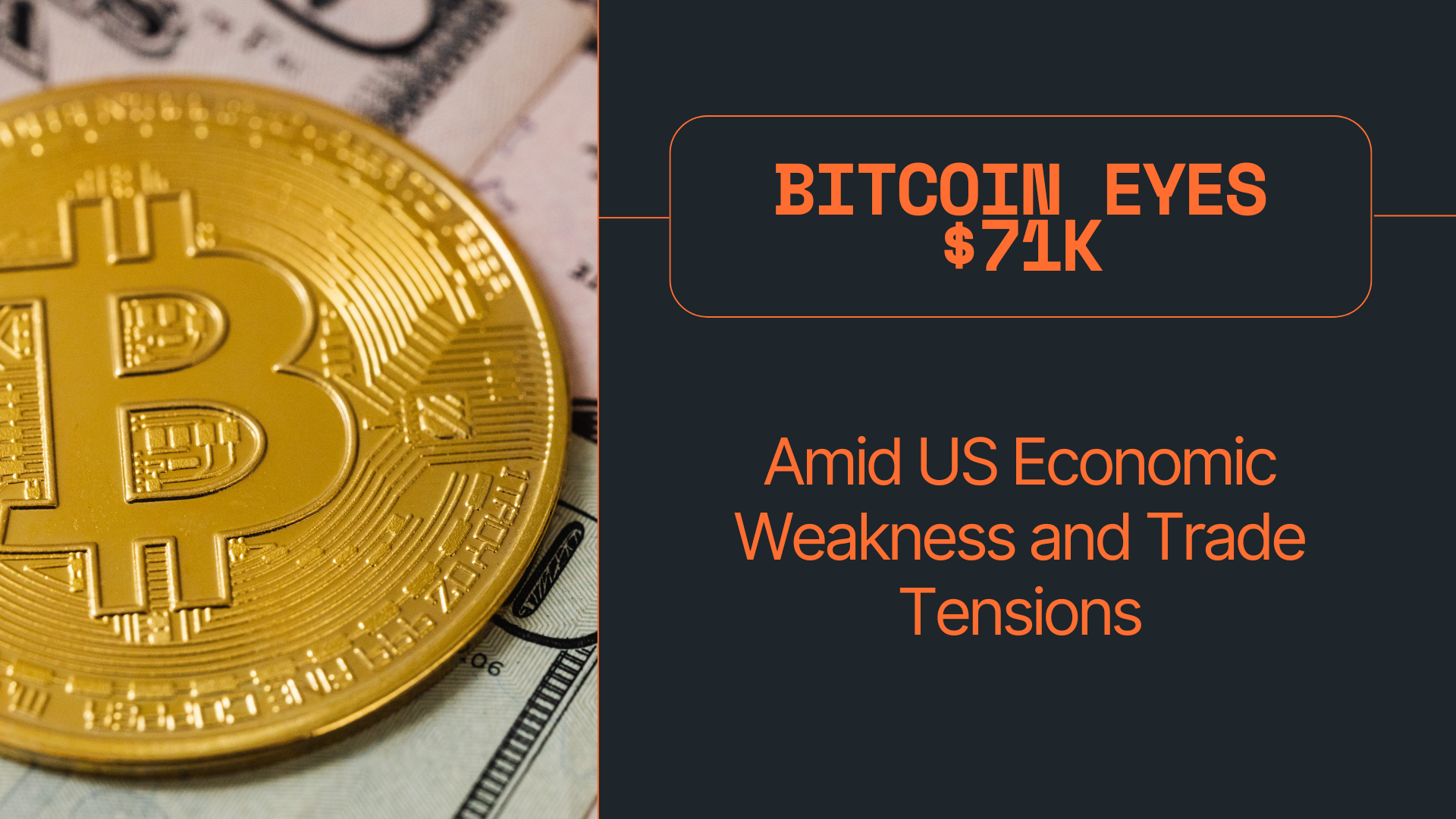
Bitcoin (BTC) is once again stealing headlines as its price inches closer to the $71,000 mark, fueled by a rare convergence of macroeconomic uncertainty, geopolitical trade dynamics, and investor risk sentiment. As of late March 2025, Bitcoin continues to hover above the crucial $70K resistance, signaling potential for another breakout.
Analysts are eyeing $71K as the next technical target, bolstered by waning business confidence in the United States and renewed discussions around tariffs on Chinese goods, which could weigh heavily on traditional markets.
This article explores what’s fueling Bitcoin’s surge, what economic indicators investors are watching, and how global uncertainty could cement BTC’s position as “digital gold.”
Bitcoin Price Momentum Builds After Breakout
Bitcoin’s recent rally has been anything but accidental. After a period of consolidation, BTC reclaimed the $70K levelearlier this week, fueled by positive crypto market sentiment and a flurry of institutional inflows.
According to on-chain analyst Matthew Hyland, Bitcoin is exhibiting strong trend continuation signs after consolidating around $68,000. “BTC is attempting another breakout and is holding the breakout trend,” Hyland shared with his 140,000+ followers on X (formerly Twitter).
His technical analysis indicates that $71,000 is the next major resistance, and if broken, could open the door to new all-time highs in Q2 2025.
US Business Outlook Hits Rare Lows
Bitcoin’s bullish momentum isn’t just technical—it’s macroeconomic.
Data shows a rare decline in the United States business outlook, suggesting growing skepticism about future economic performance. This downturn in corporate confidence could prompt the Federal Reserve to adopt a dovish stance, potentially avoiding further rate hikes and maintaining liquidity in markets—a trend that historically benefits Bitcoin and crypto assets.
The weak business confidence aligns with broader recession concerns, with leading indicators—like the ISM Manufacturing Index and job market participation—hinting at an economic slowdown.
This climate of uncertainty often drives investors toward alternative assets like Bitcoin, which is increasingly seen as a hedge against macro instability.
Tariffs and Trade War Rhetoric Resurface
Amid growing geopolitical tension, U.S. trade policy is back in the spotlight.
Reports indicate that policymakers in Washington are considering tariffs on Chinese goods as part of a potential “reciprocal trade deal” with Beijing. This echoes the rhetoric of earlier trade conflicts, which rattled global markets and disrupted traditional equity flows.
Tariffs could have wide-reaching effects on inflation and global supply chains, prompting risk-off sentiment across the stock market—another catalyst for Bitcoin adoption.
Historically, during periods of trade tension or capital controls, investors have turned to decentralized assets like Bitcoinas a way to preserve value beyond borders.
Market Reactions and Crypto Comparisons
As Bitcoin approaches $71K, Ethereum (ETH) and other major altcoins are also experiencing modest gains. ETH is hovering near $3,650, with Solana (SOL) trading around $130 and XRP reclaiming the $0.65 zone.
Crypto exchanges such as Binance, Coinbase, Bybit, and Kraken report increasing spot and derivatives volume, reflecting growing retail and institutional interest in crypto markets amid traditional finance (TradFi) volatility.
Competitor platforms like OKX and Bitget are offering leverage products and BTC staking rewards, catering to users eager to benefit from short-term price action as the bullish sentiment builds.
Bitcoin as a Hedge in a Shifting Macro Landscape
One of the biggest narratives of 2025 continues to be Bitcoin’s evolving role as a macroeconomic hedge. With U.S. equities showing signs of fatigue, gold stagnating, and the dollar under pressure due to fiscal uncertainty, Bitcoin is increasingly being adopted as a “digital safe haven.”
Moreover, BTC’s fixed supply and decentralized nature offer a compelling alternative to fiat currencies, especially in an environment where monetary policy decisions remain unpredictable.
Institutional investors are also taking note. BlackRock’s Bitcoin ETF, along with similar products from Fidelity and VanEck, continue to attract inflows, providing exposure to Bitcoin without direct wallet custody—bringing traditional capital into the decentralized space.
What’s Next for Bitcoin?
While short-term resistance looms near $71K, crypto analysts believe that sustained breakouts above this level could bring targets of $75K and beyond into play. However, potential volatility from macro events—such as U.S. Fed meetings, inflation reports, and geopolitical developments—could still influence BTC’s path.
Investors are also watching for further developments on the U.S. spot Ethereum ETF approval, which could spark a new wave of capital inflows into the altcoin market, indirectly boosting Bitcoin as the sector’s bellwether.
Conclusion
Bitcoin’s march toward $71K comes at a crucial moment for global finance. Weak business confidence in the U.S., looming trade tensions with China, and an uncertain Federal Reserve trajectory are converging to reshape investor strategies—with Bitcoin emerging as a key beneficiary.
As the traditional economic playbook continues to unravel, crypto markets—led by BTC—are proving to be both resilient and responsive. Whether Bitcoin can decisively break past $71K remains to be seen, but one thing is clear: Bitcoin is no longer just a speculative asset—it’s a global macro asset in the making.